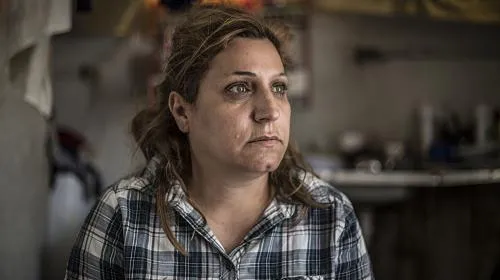For every Syrian who returned home last year, three more were newly displaced
AMMAN (Feb. 5, 2018) – Hundreds of thousands of refugees are at risk of being pushed to return to Syria in 2018, despite ongoing violence, bombing and shelling that are endangering the lives of civilians, leading humanitarian agencies warn in a report released today. The warning comes amid a global anti-refugee backlash, harsher conditions in neighboring countries hosting Syrians, and Syrian government victories in the conflict that have fueled misleading rhetoric suggesting Syria is safe for refugees to return.
The report by CARE International, the Norwegian Refugee Council (NRC), Save the Children, Action Against Hunger, Danish Refugee Council (DRC), and International Rescue Committee (IRC) warns that governments in Europe, the United States and the region are closing borders and forcing Syrian refugees back – or openly discussing measures for it – putting many lives at risk. Despite Syria’s changing military situation, the country is still volatile and dangerous as recent military escalations in Idlib and Eastern Ghouta demonstrate.
The report found that while the number of Syrians returning – mostly from internal displacement inside Syria – rose from 560,000 to 721,000 between 2016 and 2017, for every returnee there were three more newly displaced because of the violence. Some 2.4 million people in Syria – more than 8,000 every day – fled their homes in the first nine months of 2017 and the UN predicts a further 1.5 million Syrians will be displaced in 2018.
Although 2017 saw reduced violence in some areas of Syria, it increased in other regions with hundreds of civilians being killed or injured. Aerial bombing, mortars and booby traps are still daily hazards, including in populated areas.
Yet with conditions deteriorating for many refugees in the region, and few resettlement opportunities in other countries, many seeking safety could end up taking dangerous and illegal routes to reach alternative countries or feel pushed to return to Syria.
NRC Secretary General Jan Egeland said: “The majority of Syrian refugees and internally displaced live under terrible conditions and want to return home, but their return must be informed, voluntary, safe, assisted and protected. Now, return would neither be safe nor voluntary for the vast majority who fled the war and the violence. We stand ready to assist safe and voluntary return when there are lasting ceasefires, rights are protected and societies can be rebuilt without fear. Currently, even in certain so-called de-escalation areas, we’ve seen bloodshed, targeting of hospitals and schools, and death.”
The report also calls for greater action to help refugees in Jordan, Lebanon and Turkey. While these countries have shown remarkable generosity in the past, the lack of political will from wealthy countries to help has created a feeling that closing borders and returning refugees is justified.
Wealthier countries have failed to meet committments made at conferences in London in 2016 and Brussels in 2017. In 2017, the UN High Commissioner for Refugees (UNHCR) more than halved submissions for resettling Syrian refugees to rich countries compared with the previous year. The U.S. administration’s actions to cap the resettlement quota and barring Syrian refugees account for much of the fall in numbers, but other nations have failed to step up. Politicians in Europe, notably in Denmark and Germany, are now discussing the deportation of refugees to Syria. Yet, to date, only three percent of vulnerable Syrian refugees have been resettled in wealthy countries.
Carolyn Miles, CEO of Save the Children, said: “No child should have to return home before it is safe. Right now, many parts of Syria are unsafe for children. Bombs are still falling and basic services like schools are hospitals lie in ruins. Children have told us of the deep psychological wounds they carry after enduring years of war. Many children are still having nightmares. Once there is peace, the homes and schools of Syria must be rebuilt before children return. The Syrian refugee children we have spoken to want nothing more than to go home to Syria, but they can only do so when it is safe and sustainable to return.”
Christian Friis-Bach, Danish Refugee Council Secretary General, said: “Safe and sustainable return means that you can return to your home, be safe and have access to water, schools and health clinics. I have just visited Aleppo, Homs and Damascus and could witness the destruction and still hear the bombings. Without a stable political and security solution, guarantees and reconstruction, we cannot and should not force people back. We need their return to be voluntary, safe and sustainable, or the future will be unforgiving and will remind us of our failures.”
The report highlights there is a massive, costly task ahead to rebuild the country’s shattered infrastructure. Almost half of those displaced in the south of Syria, interviewed by NRC, said their homes had been damaged beyond repair or destroyed. In the north west of Syria, only one in five reported their home was still intact. Half of Syria’s health facilities have been destroyed or shut down. One in three schools are damaged, destroyed or used for other purposes.
ABOUT CARE
Founded in 1945, CARE is a leading humanitarian organization fighting global poverty. CARE places special focus on working alongside poor girls and women because, equipped with the proper resources, they have the power to lift whole families and entire communities out of poverty. Last year, CARE worked in 94 countries and reached more than 80 million people around the world. To learn more, please visit www.care.org.
Media Contact
Nicole Ellis, +1-202-560-1791, nicole.ellis@care.org to obtain photos or set up an interview with CARE experts in the region.

